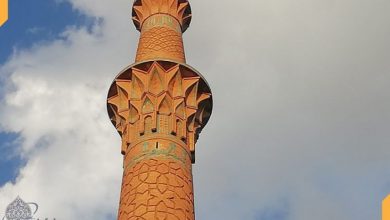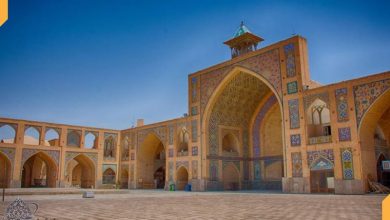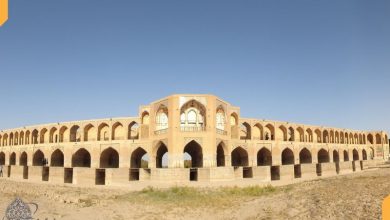Choobi Bridge or Joubi Bridge in Isfahan?

One of the questions that arises for many the tourists of Isfahan when they faced with Choobi bridge, is that is this bridge really made of wood Or the wood is being used in it or merely its name is joubi bridge? Also, what was the reason of constructing such a beautiful bridge in the Zayandeh Rood?
Choobi Bridge which has been written by some historians as Joubi bridge and is still known by the same name today is the name of a bridge in Isfahan and on the Zayandeh River. This bridge was a special way to get to the entrance of the Haft-Dast Palace and the Ayene_Khaneh pavilion, and on this bridge there was water.
For this reason, it was called Jobi Bridge. It is a bridge with a width of 147 meters in the city of Isfahan, located between the two bridges of Al-Lahordi Khan and Khajoo Bridge. This bridge was built by the order of Shah Abbas II in 1065 AH.
In the itinerary of Sharden:
it is directly pointed that the bridge is made from the wood that is based on a stone. so we can’t say with certainty that the title of wooden bridge was pronounced easily in the slang language of the people of Isfahan.
Choobi Bridge; Architecture
This bridge, which has a small width and a length of about 147 meters on the Zayandeh River, is built between the two bridges of Allahverdi Khan and Khajoo Bridge. It is one of the structures of Shah Abbas II period in 1065 AH.
The hexagonal tower in the middle of the bridge and the springs of water were very pleasant for the emirs, nobles, guests, and ambassadors who came to visit the king.
In the western part of this bridge, the river water turned into a lake, which is why it was also called “Lake Bridge”. It is also called Saadatabad Bridge. This bridge is now located on Kamal Ismail Street.
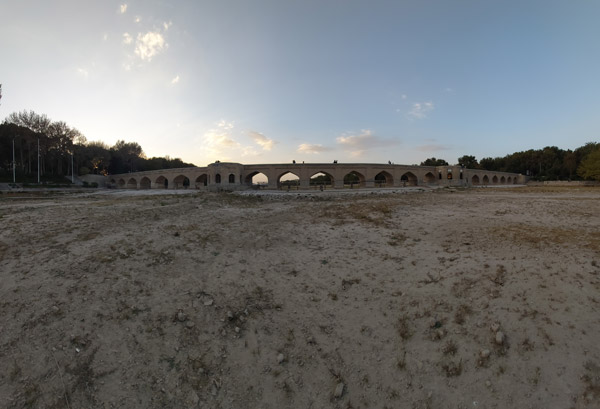
The bridge has 21 openings with gothic arches and two small chambers in the middle. There is a hexagonal tower in the middle with flowing springs on each side. Unlike other bridges, this bridge, due to its long length and small width, has been strong against natural disasters.
Mortar has been used in its foundations, and bricks with gypsum mortar have been used in all its bodies and even its arches.
Unlike other bridges, the purpose of this bridge was not to cross, but to connect the northern and southern gardens, and it was used only to cross Shah Abbas and his family and to meet with merchants, ambassadors and foreigners because this Bridge connects Saadatabad Garden in the north to the Haft-Dast garden in the south.
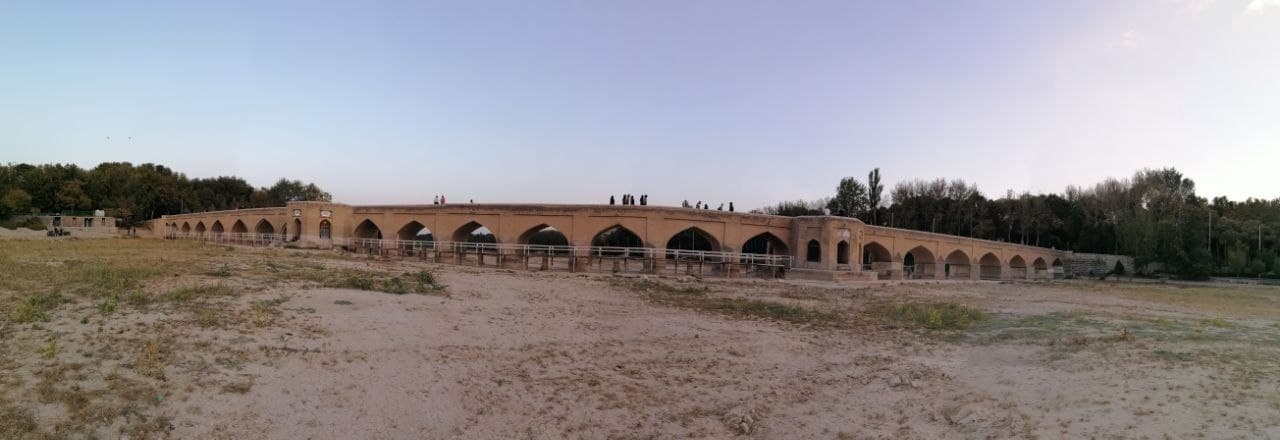
History
Joubi Bridge was in the west side of two beautiful and famous palaces, named Haft-Dast and the Mirror Palace. The length of this bridge is long and it has remained well safe during different times and different events and it has not been seriously damaged.
Therefore, visiting it can be a very valuable experience. The date of the construction of this bridge dates back to 1064 AH during the Safavid period. Hardly can you find a masterpiece in Isfahan that is not somehow related to the Safavid period! The bridge was built by order of Shah Abbas II.
As mentioned, there is a tower in the middle of the bridge. In ancient times, royal guests and ambassadors came to this tower and the king met them there. Yes! You will visit the bridge where the most important leaders of the country once passed and watched the Zayandeh River.
The Name of This Bridge
The reason for naming this bridge “Jubi” is due to the proximity of a small and delicate spring of Persian stone that flowed water from one side to the other side of the bridge and it is known that it was built on the bridge during the Safavid era. However, Chardin, in his book, explicitly mentions this bridge is made of wood on a stone base, and it cannot be said that the title “joui bridge” is incorrect.
Its original name was “Saadatabad” bridge and in accordance with its proximity to Haft palace of the royal palaces of Shah Abbas II, it was also called “Haft-Dast” bridge.
In the eastern and western parts of this bridge, the river water accumulated on top of each other in the form of a lake and it was also called “lake bridge”. In the book “Favayedol-Safaviye”, which is one of the sources of the history of Safavid era, it is clearly mentioned that the name of this bridge is “Saadatabad Bridge”, and the author of that book in Safavid time mentioned “new city” around Saadatabad Garden in 1069 AH and at the same time with the seventeenth year of reign Shah Abbas II.
One of the foreigners that visited this bridge, wrote such a thing about that:
“The bridge with 14 arches that have the same shape and an alley was built for delivering the water to the Seven Hands castle that was located in the beach of Zayandeh Rood”.
Historical events
After a year of petty tyranny and the closing of the parliament, following the invitation of Aghanjafi and Haj Agha Noorullah Najafi Esfahani from Zargham Al-Saltanah, Bakhtiari forces reached the Silk Garden camp.
On the night of the ninth of Dhu al-Hijjah 1326, a group of Bakhtiari people led by Zargham al-Saltanah reached the soldiers in the Imam Mosque from the Jubi Bridge, and a group of people joined the city soldiers from the Marnan Gate.
The war in Naghsh Jahan Square between the Qajar government and Bakhtiari forces reached its peak and finally ended with the defeat of the ruler’s soldiers and the escape of Iqbal al-Dawla Kashi. Following this incident, the Bakhtiari constitutionalist soldiers took control of the city of Isfahan.
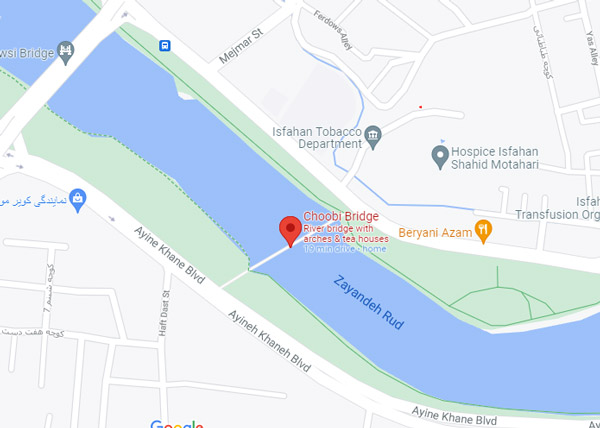
Which city is Choobi Bridge located in?
The answer to this question is very easy by reading the text above. Joui bridge, which is also called wooden bridge (Joubi bridge), is in the city of Isfahan and in Isfahan province.
This bridge is one of the old bridges of this city over the Zayandeh River and is one of the sights of Isfahan. This bridge is not intended for cars, and many people use this bridge daily to cross the Zayandeh River.
Why visit Isfahan Choobi bridge?
This is one of the most beautiful tourist attractions in Isfahan, which dates back to the Safavid era. It is better to know that you will visit one of the aristocratic bridges of Safavid era, and this is very important. We recommend visiting the bridge at night. You will see a different and a very pleasant and clear view of the bridge at night, which has been doubled by its bright lights. Reasons why it is very necessary and important to visit this bridge:
It is one of the most famous historical tourist attractions in Isfahan.
- It is located between the famous bridges of Isfahan that are Siosepol bridge and Khajoo bridge, and you can easily visit them as well.
- Once upon a time, the most important people and heads of government passed by it and went to the surrounding palaces.
- Visiting this bridge, you will see musicians and artists who have doubled the pleasure of being on the bridge with their beautiful voices and instruments. You will see this more at night.
- All around the bridge are green spaces where friends and families and people, in general, can gather together and have fun.
- A cafe called Cafe Farhang has been set up under the bridge, where you can arrange your friendly and business appointments. It is surprising that an old building from the Safavid era has the potential to gather people together.
The address of the beautiful Joubi bridge is in Isfahan province, Isfahan city, and Kamal Ismail street. You can get to the bridge by car, metro, and taxi. You can use the Siosepol Bridge Metro Station, which is only 100 meters away from the Siosepol Bridge.
Necessary information for your visit
You are not going to pay any fee to visit the bridge. Make sure to visit the bridge in addition to visiting the Khajoo Bridge and Siosepoal Bridge in Isfahan. This bridge was built during the Safavid period. You will see beautiful and different views of Zayandehrood and Isfahan on this bridge.
You will have access to public transportation to get to Choobi bridge. Around this bridge, there are restaurants, residences, buffets and other tourist attractions such as Khajoo Bridge that will make your trip easier and more enjoyable.
As you know, the climate of Isfahan is hot and dry and it has very hot summers. For this reason, we suggest that you come to Isfahan in spring and autumn because it has a better climate. You can visit the bridge during the day, but visiting the bridge at night will be a different experience.
So during your trips to the beautiful city of Isfahan, be sure to visit the historical bridges in this city such as Khajoo Bridge and Choobi bridge.
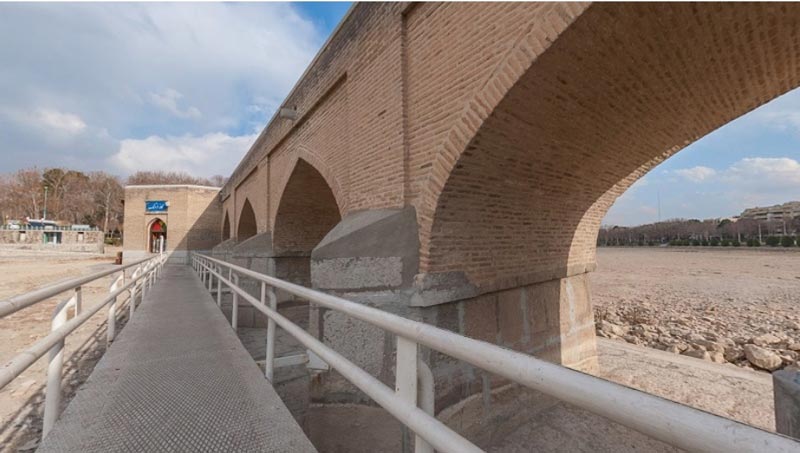
Different parts of Isfahan Joubi Bridge
From the appearance of the bridge, it is clear that this is a one-story bridge. Since in the past it was used for people to pass through the palaces of the Haft-Dast and the Ayene-Khane, it is considered a royal and a private way.
The joui bridge has a 6-meter width and is 147 meters long. So we are not dealing with a normal and a small bridge at all. This was once the only connection between the southern and northern parts of the river.
Vast gardens were located between Siosepoal bridge or Allah Verdi Khan Bridge and Khajoo Bridge. On the other hand, the only way of connection to the Safavid palaces and pavilions, among which we can name the Haft-Dast Palace, Ayene-Khane, Kashkol, and Namakdan is by means of this Bridge.
The various parts of the bridge include 21 openings for the bridge piers, a path at the top of the bridge to cross, two chambers along the bridge, and a tall tower that is no longer visible.
A lot has been mentioned about Choobi Bridge in foreign books and travelogues. Somewhere, It is said that Choobi Bridge was a canal to supply water to Haft Dast Palace and they did it so well.
Unfortunately, there were magnificent mansions around this bridge that we named, you may ask about these mansions today, but there aren’t any of them anymore. These buildings and structures are the same buildings and monuments that were destroyed by Massoud Mirza.
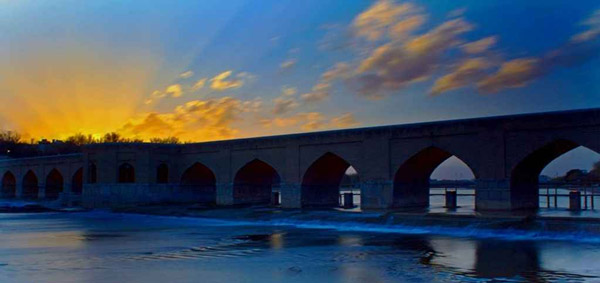
Distance between Choobi Bridge to different places
1- Wooden bridge to the path of Baba Rokanuddin tomb:
- Distance 4 km
- A five-minute interval
- Based on an average speed of 50 km / h
2- To Khajoo neighbourhood:
- Distance 1 km
- A one-minute interval
- Based on an average speed of 50 km / h
3- To the tomb of Valeh Esfahani:
- Distance 3 km
- A four-minute interval
- Based on an average speed of 50 km / h
4- To Siosepoal bridge
- Distance 1 km
- A one-minute interval
- Based on an average speed of 50 km / h
5- To Madi Niyasarm
- Distance 1 km
- A one-minute interval
- Based on an average speed of 50 km / h
6- To Mir Fendereski Tomb
- Distance 2 km
- A two-minute interval
- Based on an average speed of 50 km / h
FAQ:
- Where is the Joubi bridge?
in Isfahan and on the Zayandeh Rud river - What are the other names of the Joubi bridge?
Jouee Bridge, Choobi Bridge
Conclusion:
Zayandeh Rud and the bridges located on it are among the valuable attractions of Isfahan. They cannot be simply ignored.
Because they are both historical monuments and have a unique and amazing nature. Of course, not all of these bridges are as well known as the Siosepol Bridge and the Khajoo Bridge.
Unfortunately, there are not many names and symbols of them, but when you travel to Isfahan and calmly cross the busy Ferdowsi Bridge and look at the Jubi bridge from the distance, you certainly can not pass through the pristine nature and watch the white birds that gather around a little water and fly over. You will definitely want to walk on this bridge and take some photos.
 Have you ever walked on this bridge? Do you have any memento in the cafe beneath the bridge? If you have any experience or memento about this bridge, we thank that you share it with us.
Have you ever walked on this bridge? Do you have any memento in the cafe beneath the bridge? If you have any experience or memento about this bridge, we thank that you share it with us.


